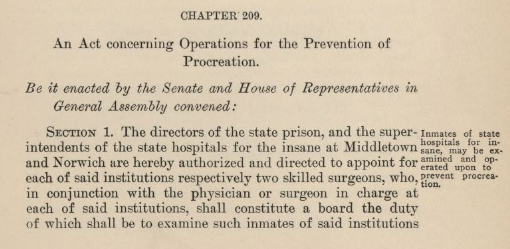Allison Norrie
Fairfield Public Schools
TEACHER'S SNAPSHOT
Subjects:
Health & Medicine, Law, Progressive Era, Racism, Reform Movements, Science
Course Topics/Big Ideas:
Role of Connecticut in U.S. History, The Impact of Science and Technology on Society
Town:
Hartford, New Britain
Grade:
High School
Lesson Plan Notes
The Progressive Era (ca. 1896-1916) in the United States was characterized by the growth in popularity of reform-based social, political, and economic movements. Generally, this historical period is associated with groundbreaking reforms. However, not all these reforms were benevolent. In 1907, influenced by the pseudo-scientific writings of men like Francis Galton and Havelock Ellis, the state of Indiana passed the first eugenics legislation in global history. Connecticut followed shortly thereafter passing its own eugenics legislation in 1909. The word “eugenics” comes from Greek, meaning “good birth.” These policies of forced sterilization in the name of ridding cities of vice, as well as in pursuit of American racial purity during the height of transatlantic immigration, were validated by the United States Supreme Court in the case of Buck v. Bell in 1927. Connecticut continued to enforce this legislation well into the 1960s, though with less frequency.
ESSENTIAL QUESTION
SUPPORTING QUESTIONS
- What social, economic, and/or political forces contribute to government policies that limit the rights of some citizens?
- How does the pseudo-science of eugenics compete with the idea of the “American Dream?”
- To what extent has society’s perception of appropriate treatment for mental health issues changed in the past 100+ years?
ACTIVITY
- Using the primary sources in the toolkit, engage in a QFT (Question Formulation Technique) exercise in small groups. For modified lessons and/or vocabulary and language lessons, please see the Eugenics Law Vocabulary List in the toolkit above.
- Investigate the broader social, political, economic trends of the Progressive Era in Connecticut, as well as nationwide, and consider the eugenics movement within that context.
- Research historical parallels and/or current events relating to mental health, public health, and public policy.
- Use the Chronicling America database (chroniclingamerica.loc.gov) to find additional information about eugenics and race in the Progressive Era.
- For organizing investigations and research, have students use an ESPE (Economic, Social, Political, Environmental) Graphic Organizer or other graphic organizer of your choice.
OPPORTUNITIES FOR ASSESSMENT
- Individually, students can investigate current government policies/initiatives they would like to see improved and write an op-ed or letter to their local legislator advocating for change.
- Individually or in groups, students can create a digital exhibit tracing the historical importance of a reform movement or government policy of their choosing.
RESOURCE TOOL KIT

“An Act concerning Operations for the Prevention of Procreation.” Public acts passed by the General Assembly of the state of Connecticut, 1909-1911. Title 22, Chapter 137, Sections 2691 and 2692.

Eugenics Law Vocabulary List
ADDITIONAL RESOURCES
Places to GO
Find out more about Connecticut legislative history with a visit to the Connecticut State Library.
Learn more about the legislative process in Connecticut today by visiting the Connecticut State Capitol.
Things To DO
Watch “The Eugenics Crusade: What’s wrong with perfect?” from American Experience on PBS.
Websites to VISIT
Articles to READ
Beach, Randall. “The State’s Only Prison for Women Began as a Working Farm.” Connecticut Magazine. September 17, 2018.
DenHoad, Andrea. “The Forgotten Lessons of the American Eugenics Movement.” The New Yorker. April 27, 2016.
Greenfield, Briann. “Donald Lines Jacobus and the Making of American Genealogy.” Connecticut Explored. Fall 2019.



